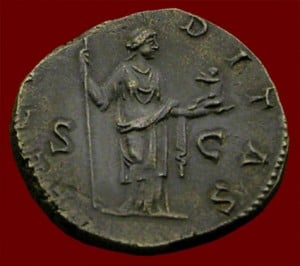Before the conclusion of Vestalia I should return to the Vestal Virgins in order to once again show the special role women play in the religio Romana.
When Numa Pompilius founded our tradition he laid down regulations on the conduct of Roman sacrifices. It may be a surprise to some that Numa said, “Sacrifices are not to be celebrated with an effusion of blood, but consist of flour, wine, and the least costly of offerings (Plutarch, Numa 8.8).” Indeed, sacrifices which he is said to have founded for Vesta, Carmenta, Fides, and Terminus, and in celebration of the founding of Roma at Parilia (21 April) do not permit the use of any blood sacrifices. Those were introduced later under the Greek Tarquinians who arrived from Etruria. At their expulsion and the return to the Numa tradition at the beginning of the Roman Republic, blood sacrifices were again disallowed, and were again reintroduced along with foreign cultus. Today cultores Deorum Romanorum have once again returned to the Numa tradition and reject the use of blood sacrifices. Numa also said that “(Into your rites) the Gods are not to be represented in the form of man or beast, nor are there to be any painted or graven image of a deity admitted (ibid. 8.7).” As I mentioned earlier, Vesta was represented by a living fire alone. Carmenta, likewise, was never represented in any form. Her presence, or numen, in Her sacred grove was all that was ever needed. Early in Rome’s history the Gods were often represented by trees, sometimes by planks of wood painted white, or, the most ancient form of representation, by a wooden post draped with a toga. Painted images and painted statues came to serve as decorations, and inside temples statues served as a object in which a God might infuse His numen, but altars were placed outside of temples and images of the Gods were not really used at sacrifices as in other ancient traditions. There are several Numa ordinances concerning how sacrifices are to be made, and one of the most important ones says that:
“No sacrifices shall be performed without meal (ibid. 14.3).”
This refers to the mola salsa that was required at all sacrifices performed by the rex sacrorum and the flamines maiores. It is a course meal of grain that was specially prepared by the Vestal Virgins. As an essential element in any Roman sacrifice performed by the highest priests it shows once again the very significant role played by the Vestal Virgins in the religio Romana.

Late in the month of November ships would be sent far out to sea to gather water. Baked in porous jars, the sea water produced cakes of salt that the Vestals would cut with an old style saw. The Vestals placed this purified salt into water that they had carried from a spring near the sacred grove of Carmenta. In the month of May the Vestals would pick the earliest heads of winter wheat, which would be soaked in this brine before being roasted. Then the salted grain was ground into a course meal. Some believed that salt was again mixed into this meal. It was then distributed annually, on 1 February, to the rex sacrorum to use for his monthly rituals, to the flamen Dialis who made daily sacrifices, and to the flamines Martialis and Quirinalis as well. In order to sanctify any offering for sacrifice, it first had to be sprinkled with mola salsa produced by the Vestal Virgins.
In the private home, so we assume, a similar product would have been made by the daughters of a household under the direction of the domina. Modern cultores Deorum produce their own versions of mola salsa, some making it with spelt and salt, while others prefer kinds of wheat.
The Vestals also made another product, similar to mola salsa, from grain and salt, which was distributed to the lictors who accompanied the priests and Vestals (other lictors who carries the fasces accompanied Roman magistrates). Whenever someone died in a home, and most Romans would die in their beds, then the house, and the family, had to be purified. This would involve a number of rituals in addition to the funeral for the dead. One ritual in particular saw the sacerdotal lictors arrive with the salt and grain. This they would sprinkle around the rooms as a kind of offering to any Manes who had lingered around the deceased. This was then swept up, along with any illness or evil that might be present, and deposited in an appropriate place outside the City.
When you think of just how large Rome was, and it grew to become the largest city in the ancient world with over a million residents, and all the years this practice was continued, from its founding in 753 BCE until 382 CE when the college of Vestals was officially disbanded by the Christian emperor Gratianus, then one begins to see just how great a role the Vestals played in the religious life of Rome. Further, they did not produce mola salsa and the purification salt alone. There were other sacrificial substances that the Vestals alone made. There were special rituals that they performed in public, as well as other public rituals which they were required to attend. They did not attend all of Rome’s public rituals. There were only six Vestals at any one time and two were required at any given time to attend to Vesta’s eternal flame. But we find them at some of the most important public ceremonies, and always at ceremonies intended to purify the City of Rome.
In the private home, the lady of the house, the domina, would have the role of the Virgo Maxima, and her daughters would fill the role of the other Vestal Virgins. They cared for the hearth fire daily, just as the Vestals cared for Vesta’s fire. The domina was the last person to go to bed each night, responsible for seeing that the hearth had been properly cared for so that its embers would remain throughout the night without causing a fire. Three times each month at least, and at any other time it was required, the domina directed the purification of the home. While daily rites before the family lararium were conducted by her husband when he was home, the domina conducted rites before any of the daily household chores were performed. And like the Vestal Virgins as well, the matrons of Rome were called upon to perform public ceremonies on behalf of Rome, and also to participate in womens rites on various festivals. That is, in addition to filling a central religious role in the home, the women of Rome, or really a special segment among married women, also held a special place in the religious life of the City. These were the matronae, whose appearance in public ceremonies I will take up in a later post. There was, I think, a stronger connection between the matrons of Rome and the Virgo Maxima than is normally assumed. The domina of a house was a central figure in the religious life of the home, alongside her husband who tended more to the cultus of the land. A matrona was likewise a domina but also something more, and did not merely fill the role of the Virgo Maxima or that of the flamenica Dialis in the private home. Matronae served a very public function as well in the religio Romana. So the importance that women had in ancient times, and that needs to be recognized for women in the modern practice of the religio Romana today, is involved with but not limited to the Vestal Virgins.















